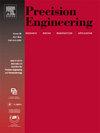优化磁流变整理液中离子化聚合物的加工稳定性
IF 3.5
2区 工程技术
Q2 ENGINEERING, MANUFACTURING
Precision Engineering-Journal of the International Societies for Precision Engineering and Nanotechnology
Pub Date : 2025-01-24
DOI:10.1016/j.precisioneng.2025.01.018
引用次数: 0
摘要
磁流变精加工技术在半导体和光学加工中得到了广泛的应用。整理液的性质对整理质量有很大的影响。研究表明,聚苯乙烯磺酸钠(PSS)作为分散剂加入整理液中,可以有效提高抛光性能,保持整理液的加工稳定性。在MRF加工中,添加0.2% PSS的组将熔融二氧化硅(FS)工件的粗糙度(Rq)降低到1.02 nm,而对照组为4.3 nm。PSS提高了磨料颗粒的表面电位,通过增强静电斥力来阻碍磨料团聚。同时,整理液的使用寿命显著延长3倍以上。PSS的加入显著降低了羰基铁颗粒(cip)的氧化。能谱分析显示,钻石磨料划伤了cip。划伤的cip容易被氧化成Fe3+,从而导致精加工液的严重失效。PSS吸附在颗粒表面,产生空间位阻,减少磨料和cip之间的摩擦。加入PSS的MRF液Fe3+浓度明显降低。这两种机制同时增强了处理的稳定性。本文章由计算机程序翻译,如有差异,请以英文原文为准。

Optimizing processing stability with ionized polymers in magnetorheological finishing fluid
Magnetorheological finishing (MRF) is being widely utilized in Semiconductor and optical processing. The properties of the finishing fluid have a great influence on the finishing quality. This study revealed that sodium polystyrene sulfonate (PSS), when employed as a dispersant in the finishing fluid, effectively enhances the polishing performance and maintains the processing stability of the finishing fluid. In the MRF processing, the group with the addition of 0.2 % PSS achieved a reduction in the roughness (Rq) of the fused silica (FS) workpiece to 1.02 nm compared to 4.3 nm in the control group. The PSS elevated the surface potential of abrasive particles, impeding abrasive agglomeration by reinforcing electrostatic repulsion. Simultaneously, the operation life of the finishing fluid significantly extends more than 3 times. The addition of PSS resulted in a significant decrease in the oxidation of Carbonyl iron particles (CIPs). Energy spectrum analysis revealed that diamond abrasives scratched the CIPs. Scratched CIPs were prone to be oxidized to Fe3+, thus leading to the significant failure of the finishing fluid. PSS adsorb to particle surfaces, creating steric hindrance that reduces friction between abrasives and CIPs. The MRF fluid with PSS exhibited a notable reduction of Fe3+ concentration. Both mechanisms concurrently enhanced the processing stability.
求助全文
通过发布文献求助,成功后即可免费获取论文全文。
去求助
来源期刊
CiteScore
7.40
自引率
5.60%
发文量
177
审稿时长
46 days
期刊介绍:
Precision Engineering - Journal of the International Societies for Precision Engineering and Nanotechnology is devoted to the multidisciplinary study and practice of high accuracy engineering, metrology, and manufacturing. The journal takes an integrated approach to all subjects related to research, design, manufacture, performance validation, and application of high precision machines, instruments, and components, including fundamental and applied research and development in manufacturing processes, fabrication technology, and advanced measurement science. The scope includes precision-engineered systems and supporting metrology over the full range of length scales, from atom-based nanotechnology and advanced lithographic technology to large-scale systems, including optical and radio telescopes and macrometrology.

 求助内容:
求助内容: 应助结果提醒方式:
应助结果提醒方式:


